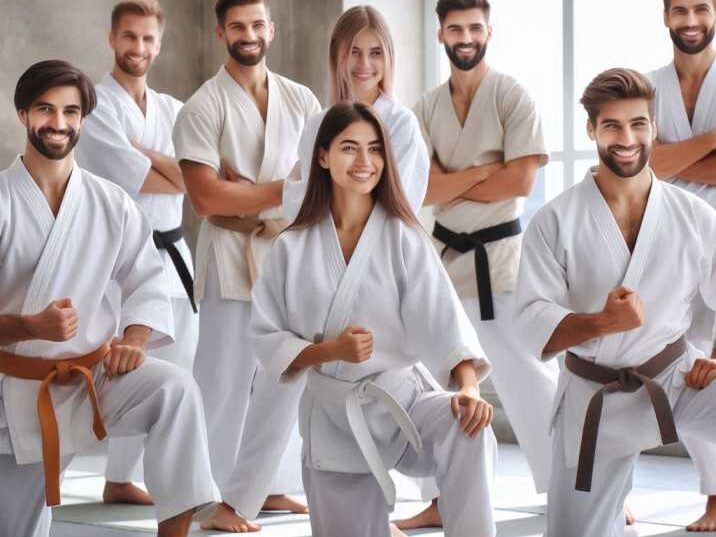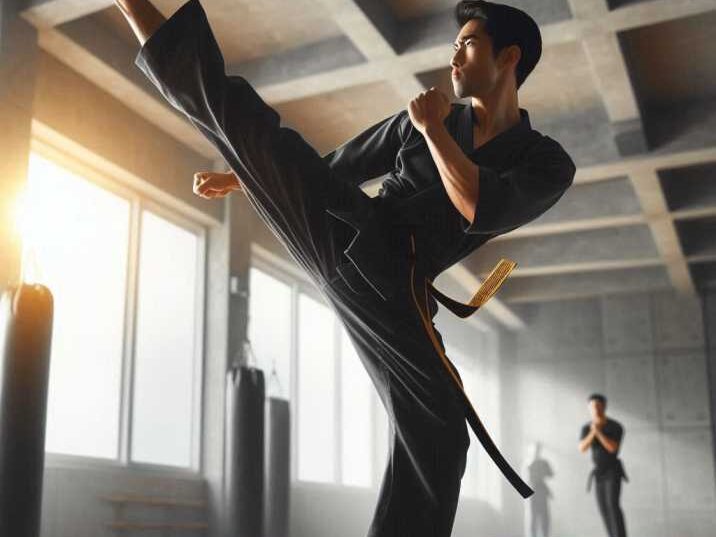Introduction
Table of Contents
Starting martial arts might seem intimidating if you think it’s only for people who are already super fit. But here’s some good news—you don’t have to be fit to start martial arts! In fact, martial arts training can help you get fit while teaching you valuable skills. This article will explore why you don’t need to be in great shape to start martial arts and how it can benefit people of all fitness levels.

What Is Martial Arts and Why Do People Practice It?
Martial arts are forms of self-defense that have been practiced for centuries. They come in many styles, like karate, taekwondo, judo, and Brazilian jiu-jitsu. People practice martial arts for many reasons—to get stronger, learn self-defense, improve their discipline, and boost their confidence.
Do I Need to Be Fit to Start?
The short answer is: No, you don’t need to be fit to start martial arts. Here’s why:
- Martial Arts Training Is for All Levels
Martial arts welcomes people of all fitness levels. Instructors tailor classes to match your ability, whether you’re a beginner or already fit. You’ll start with basic movements and build your skills at your own pace, without needing to be in top shape from the beginning. Over time, your strength, coordination, and endurance will naturally improve.
You Will Build Fitness Over Time
Martial arts training is a full-body workout that helps you gradually build fitness. Through regular practice, you’ll develop: - Strength – Martial arts exercises like punches, kicks, and grappling use your own body weight, helping you naturally build muscle strength without needing heavy weights or equipment.
- Flexibility – Regular practice of kicks, stretches, and various movements improves your flexibility. Over time, you’ll notice increased range of motion and reduced stiffness.
- Endurance – Martial arts involves cardio-heavy drills such as sparring and bag work, which increase your heart rate and improve your stamina, allowing you to train for longer periods without tiring.
- Balance & Coordination – Learning techniques like kicks and throws enhances your balance and coordination. The more you practice, the better control you gain over your body’s movements.

Each Session Gets You Closer to Your Fitness Goals
Each martial arts class moves you closer to your fitness goals. Whether it’s gaining strength, increasing flexibility, or boosting endurance, you’ll make steady progress. You don’t need to be fit to start—martial arts helps you get fit while learning valuable skills.
How Martial Arts Can Help You Get Fit
Starting martial arts can be a great way to improve your overall health and fitness. You’ll benefit in several key areas:
1. Strength Training
Martial arts uses your own body weight to build muscle strength. Through movements like punches, kicks, and grappling techniques, you’ll naturally develop stronger muscles.
2. Cardiovascular Health
Martial arts classes often involve high-intensity drills that improve your heart health and endurance. These activities, such as sparring or bag work, keep your heart rate up and help you burn calories.
3. Flexibility
Kicks, stretches, and movements in martial arts enhance your flexibility over time. You don’t need to be flexible to start, but you will notice improvements after a few weeks of practice.
4. Coordination and Balance
Learning different martial arts techniques helps improve your balance and coordination. The more you practice, the better control you have over your body’s movements.
Benefits of Martial Arts Beyond Fitness
Martial arts is more than just a way to get fit. Here are other benefits you’ll gain:
1. Mental Focus and Discipline
Martial arts training is not just about physical movement; it requires mental concentration. Learning new techniques, memorizing forms (also known as “katas”), and mastering complex combinations of movements help students build focus. This improved focus can carry over into other areas of life, such as school, work, and even daily tasks. Martial arts demand patience and persistence, especially when progress seems slow. By committing to regular practice, you naturally develop self-discipline, which can help in many other areas of your life, like time management and organization.
For example, in karate, students must repeatedly practice the same movements until they are perfected, fostering a sense of perseverance. Over time, this leads to better mental clarity and determination to achieve long-term goals, both in martial arts and outside of it.
2. Confidence and Self-Esteem
Martial arts training builds self-confidence through skill development and overcoming challenges. Every time you learn a new move, perfect a technique, or earn a belt promotion, you’re reminded that you’re improving. These achievements help boost self-esteem. As students learn to defend themselves and improve their fitness, they often feel more capable and empowered in other areas of life too.
For example, someone who once doubted their abilities might feel confident enough to try other activities or sports, knowing that martial arts has equipped them with mental resilience. When students learn how to face opponents in sparring sessions, they also develop the courage to face challenges in life. The confidence gained in martial arts can translate to better public speaking, standing up for yourself, or taking on leadership roles.
3. Self-Defense
One of the most important reasons people take up martial arts is to learn self-defense. Martial arts techniques teach you how to protect yourself if you are ever in a dangerous situation. Self-defense skills, such as blocking punches, using leverage to escape from grabs, or disarming an attacker, can be valuable tools in ensuring your personal safety.
Different martial arts styles focus on different types of self-defense. For example:
- Brazilian Jiu-Jitsu (BJJ) teaches you how to defend yourself on the ground, using techniques that allow a smaller person to defend against a larger opponent.
- Taekwondo focuses on striking techniques, like punches and high kicks, to neutralize a threat from a distance.
- Krav Maga is a martial art specifically designed for real-world self-defense, focusing on disabling attackers quickly and efficiently.
Self-defense training helps students feel more prepared and confident in unpredictable situations. Martial arts also teaches awareness, which is just as important as physical defense. Being able to recognize potential dangers before they happen is a key part of staying safe.
Additionally, knowing how to defend yourself can significantly reduce feelings of vulnerability and fear. When students practice self-defense moves, they feel more in control of their environment and capable of handling difficult situations. This sense of preparedness provides a mental peace that positively impacts everyday life.
1. Karate
Karate focuses on strikes, kicks, and blocks, teaching both offense and defense. It’s an excellent choice for beginners who want to improve overall fitness while developing self-discipline. Karate also emphasizes respect, making it a great way to build mental focus and confidence.
2. Taekwondo
Taekwondo is known for its high, fast kicks and rapid movements, helping beginners improve their flexibility and endurance. It’s a great martial art for those who want to increase leg strength and learn precise striking techniques while developing a sense of balance and coordination.
3. Brazilian Jiu-Jitsu (BJJ)
Brazilian Jiu-Jitsu focuses on grappling and ground fighting, teaching you how to use leverage to control an opponent. It’s ideal for learning self-defense, as it doesn’t rely on size or strength, making it perfect for beginners looking to defend themselves in real-life situations.
4. Judo
Judo is centered around using leverage and technique to throw and pin opponents. It’s an excellent way to build balance, coordination, and body control. Beginners will also learn how to fall safely, which reduces the risk of injury during practice.
5. Muay Thai
Muay Thai is known as the “Art of Eight Limbs” because it uses punches, kicks, elbows, and knees. It’s perfect for building strength and improving cardiovascular fitness through high-intensity training. Beginners benefit from learning powerful striking techniques while increasing stamina and agility.
Table of Information: Martial Arts Styles for Beginners
| Martial Art | Focus | Benefits | Ideal For |
|---|---|---|---|
| Karate | Strikes and Kicks | Self-discipline, Strength | Those seeking traditional martial arts |
| Taekwondo | High Kicks | Flexibility, Endurance | Building leg strength and flexibility |
| Brazilian Jiu-Jitsu | Grappling | Self-defense, Coordination | Learning ground fighting techniques |
| Judo | Throws | Balance, Coordination | Improving body control |
| Muay Thai | Striking | Strength, Cardiovascular Fitness | Intense full-body workout |
Conclusion: Start Martial Arts at Any Fitness Level
The idea that you need to be fit to start martial arts is a myth. Whether you’re in shape or not, martial arts training can help you build fitness while learning valuable skills like self-defense, discipline, and focus. So, don’t hesitate to begin your martial arts journey today—your fitness will improve as you train!
FAQs: Do I Have to Be Fit to Start Martial Arts?
- Can I do martial arts if I’m not flexible?
Yes! Flexibility improves with practice, so you can start martial arts even if you aren’t flexible yet. - Will martial arts help me lose weight?
Yes. The combination of strength and cardio exercises in martial arts can help you burn calories and lose weight over time. - Do martial arts classes have different fitness levels?
Absolutely! Most martial arts classes are tailored to all fitness levels, so beginners are always welcome. - Can martial arts improve my mental focus?
Yes. The discipline and concentration required for martial arts training can help improve your focus in school and other activities. - How long will it take to get fit with martial arts?
This depends on your starting fitness level, but most people notice improvements in strength, endurance, and flexibility after a few weeks of consistent training.


